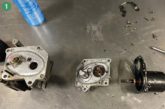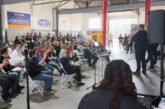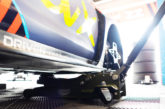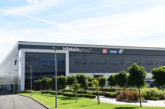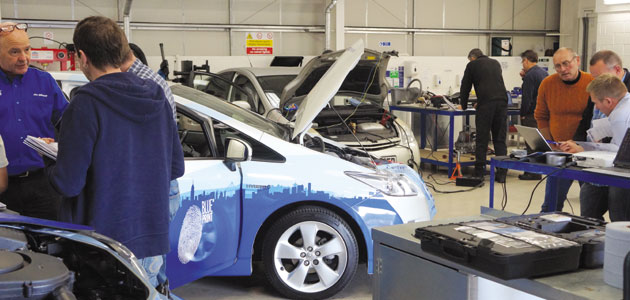
WHAT IS COVERED?
Designed and presented by Blue Print Technical Trainer, Jim Gilmour, the course is a one day event and aims to cover the following areas:
TECHNICIAN: DARREN BAMFORD, STOKE COURSE: CAN/LIN-BUS SYSTEMS COMPANY: BLUE PRINT
Electrical principles of CAN-bus- Introduction to Multiplexing and CAN-bus
- Digital explained
- Binary and hexadecimal explained
- CAN network hardware
- How the system protects itself from wiring faults
- CAN-bus and language
- LIN
- Gateways and nodes
- CAN over LIN networking
- What to do when confronted with U codes
- Multi-meters and CAN testing
- Oscilloscopes and CAN testing
- Code readers and CAN – who’s on line?
- Data logging and identifying error codes
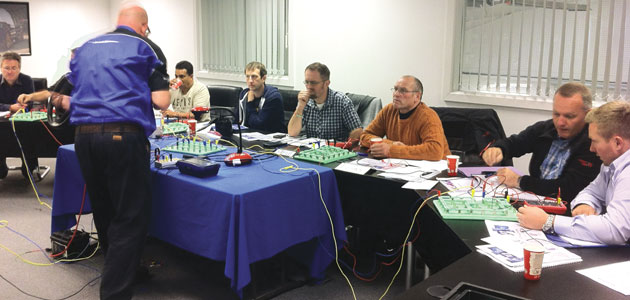
The importance of fresh technical training is often overlooked in the IAM. For many reasons it gets brushed under the carpet with most garages continuing to muddle through without fully understanding the technology used on the cars that turn up at their workshops for repair. CAN-bus is one of these technologies.
CAN-bus systems have actually been around for a lot longer than most technicians would believe. Development of the CAN-bus started originally in 1983 with a joint venture between Bosch and Intel. In the early 90’s the likes of BMW, Mercedes and Volvo were using CAN-bus in their production vehicles.
Within the last 10 years you can bet that almost every car that enters your workshop will have some form of CAN, VAN, SCP or LIN-bus installed in it.
Over the years I’ve attended various training courses that were specifically focused on CAN-bus/Multiplexing body systems, the last one being a few years ago. So when I got an invitation from PMM to attend a course laid on by Blue Print’s technical training team, I jumped at the chance.
Training structure
From the list of topics (shown below) you can clearly see there was a lot to get through in one day.
Luckily the course started bang on time and trainer Jim Gilmour did his brief introductions and explained what his aims were for the day. It was quite refreshing to see the formalities were completed within 10 minutes and we got on with the training side of things. One of my major bug-bears with some training courses that I’ve attended before is that I’ve felt time was wasted at the beginning of the day with the classroom introductions. Thumbs up to Jim on that one!
The training venue was located in the rural county of Shropshire. The actual training centre belongs to ProVq who provide technical training for both Porsche and Toyota at this location. As you can imagine, the classroom and workshops were perfect for Jim’s training session.
The training material and hand-outs provided on the day were of high quality print and can be used after for refreshing knowledge and reference and the class size was a manageable eight trainees.
Because of the varying levels of knowledge within the group I thought Jim may struggle with delivering the material to such a wide spectrum of experience. To his credit, he pitched the level just right and was able to cater for both ends of the scale.
Data dealings
When you compare CAN-bus to other vehicle electrical systems the big difference is that we’re no longer looking at analogue data; instead the data is digital. CAN-bus is the physical layer that allows the exchange of data between control units (ECU or nodes) i.e. computers talking to each other.
It is therefore important to have an understanding of how this data is constructed and how computers talk. In simple terms all computers are calculators that count numbers. The course covered this very well and explained the differences between the Denary, Binary and Hexadecimal systems of data.

How the numbers are represented
Binary numbers are just ‘Base 2’ instead of ‘Base 10’. So you start counting at 0, then 1, and then you run out of digits. You then start back at 0 again, but increase the number on the left by 1.
Hexadecimal numbers are interesting as there are 16 of them. They look the same as the decimal numbers up to 9, but then there are the letters (‘A’,‘B’,‘C’,‘D’,‘E’,‘F’) in place of the decimal numbers 10 to 15. So a single Hexadecimal digit can show 16 different values instead of the normal 10, like this:
Decimal: 0 1 2 3 4 5 6 7 8 9 10 11 12 13 14 15
Hexadecimal: 0 1 2 3 4 5 6 7 8 9 A B C D E F
The way Jim explained the differences was logical and made perfect sense. It’s nice to know the fundamentals – not that we’re all going to rush out to become software engineers. Learning this knowledge helps understand the actual CAN message and how it is constructed and displayed on the scope later on in the course.
Bright spots
The highlight of the day for me was the demonstration and explanation of the CAN signal generator and voltage divider circuit. It was very clear that Jim had spent a lot of time and effort in studying this subject. The hours he had spent in R&D paid off ‘big style’ as he has constructed his own simplified circuit of a CAN signal generator.
Using practical demonstrations with the aid of a scope and DVOM clearly showed me how and why we see the voltages we do on a high speed CAN-bus. I’m not going to give too much away here, but trust me when I say that the two 120 ohm terminating resistors pay a much bigger part in the circuit operation than I’ve always been led to believe. You’ll have to enrol on the course to get the big picture!
Course conclusion
Overall I would class the day as a complete success. It was a well presented course with good technical content. Everything progressed at a nice pace and didn’t deviate from the subject matter in hand.
Like most independent technicians out there, I’m self-employed and the time spent on training days has to offer value for money. The loss of a day’s earnings and course fees can add up to a substantial sum. I hate leaving a training session and feeling that it’s been a complete waste of time and money.
I’m happy to say that this was not the case with Blue Print’s course. Jim is a super instructor and I found his material extremely useful. If you’re looking to learn more about CAN systems then this is highly recommended.




